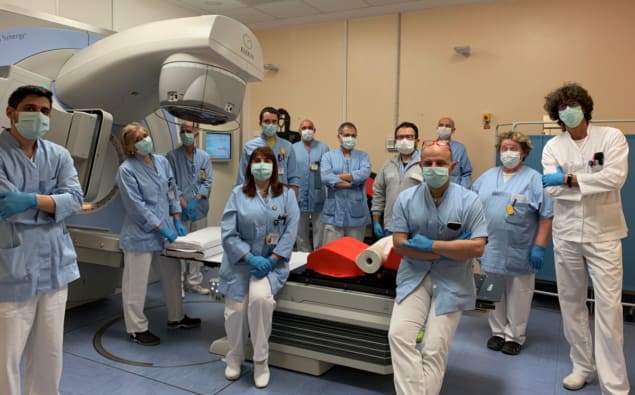Elekta’s treatment planning system Monaco enables the clinical team to successfully implement adaptive radiotherapy (ART) workflows on the Versa HD linac

Precision radiation-medicine specialist Elekta has long been a main-mover in the field of adaptive radiotherapy (ART), in which delivered dose is monitored for clinical acceptability and modified as needed during the course of treatment. The end-game: better local control of cancer; reduced toxicity and side-effects; and, ultimately, enhanced quality of life for patients.
The Elekta Unity MR-Linac is a notable success story in this regard, one of a new generation of MR-guided radiotherapy (MR/RT) systems transforming patient care and treatment outcomes in the radiation oncology clinic. Think online image guidance and ART tailored to the unique requirements of each patient. In other words, adjusting radiation delivery “on the fly” to address the daily anatomical and functional variation in the tumour and surrounding healthy tissue while allowing adaptation of the plan for tumours that respond rapidly to treatment (as well as those that prove unresponsive to standard doses of radiation).
Yet while Elekta Unity, and MR/RT more generally, have been the big headline in ART of late, it’s evident that technology and clinical innovation in ART are proceeding along multiple coordinates. Take the ongoing development of Monaco – Elekta’s proprietary treatment planning system (TPS) – with a set of tools that enables the clinical team to implement a triggered adaptive workflow on conventional Elekta linacs – most notably the Versa HD (the equipment maker’s high-end platform for advanced stereotactic treatments).
That adaptive workflow, in turn, enables what Elekta calls triggered ART, with regular offline assessment of patient anatomy – including, for example, tumour shrinkage and weight loss – versus the treatment plan for the tumour and organs-at-risk (OARs). All of which is a precursor to online adaptation of the initial treatment plan, yielding reduced uncertainties and risks when it comes to targeting accuracy and dose distribution accuracy over the course of multiple fractions. For the patient, of course, that also points the way to continuous improvement regarding treatment outcomes.
The adaptive mindset
At the clinical sharp-end of the ART development effort is Valentina Vanoni, a radiation oncologist at the Santa Chiara Hospital in Trento, northern Italy. Vanoni is part of a cross-disciplinary radiation oncology team that treats around 1400 patients each year using a suite of four Elekta linacs (all underpinned by the Monaco TPS). The clinic’s specialisms include volumetric modulated arc therapy (VMAT) for head-and-neck (H/N) tumours – the current focus of the ART programme – as well as high-dose-rate brachytherapy for gynaecological cancers and the use of intraoperative radiotherapy for a range of breast indications.

“ART is a new paradigm in radiation oncology,” explains Vanoni, “but it’s not easy and is not yet deployed as part of the routine clinical practice here.” As such, the Trento team is still very much in evaluation mode, figuring out the path to wider deployment of ART.
While the long-term clinical priority is clear – using ART to minimize dosimetric inhomogeneity to the target while maintaining planned dose to target and the associated OARs – the near-term challenge for Vanoni is more prosaic: how to set up metrics to trigger for offline adaptation of the treatment plan for any given patient.
“Daily adaptation is not an option for us because creating a new treatment plan is still a time-intensive exercise requiring a contingent of dedicated team members,” notes Vanoni. “What we have to do is compromise and adapt the treatment plan only when necessary.”
That’s the cue for Monaco’s triggered adaptive workflow to kick in, with Versa HD’s onboard cone-beam CT capability the key enabling technology for daily imaging and clinical assessment of the patient. “If more investigation is necessary,” explains Vanoni, “we subsequently export the cone-beam CT data set to Monaco to assess the need for adaptation using quantitative evaluation and responsive metrics.” Specifically, that means daily analysis of the dose-volume histogram (DVH) and associated dosimetric parameters of the original treatment plan recalculated on the “anatomy of the day”. It’s at this point that the clinician will make a go/no-go decision regarding offline adaptation of the original treatment plan.
Making the case for ART
For Vanoni and her colleagues in Trento, the priority right now is to develop the evidence case to validate the clinical and operational efficacy of ART. Online assessment, she argues, may ultimately “shift the dial” on image-guided radiotherapy from daily patient positioning to daily patient dosimetry over the medium term. A case in point is the potential for systematic use of ART in cases where the tumour target is near to critical OARs – for example, to fine-tune the dose over time to the paranasal sinus and nasopharynx tumour.
More broadly, improvements in the automatic workflows for ART – including faster, more accurate auto-contouring and ultrafast reoptimization as well as automated plan analysis – will drive the process simplification and streamlining needed for clinical adoption at scale. As for specific ART opportunities, Vanoni reckons the adaptation of the gross tumour volume (GTV) versus imaging changes could be advantageous in allowing dose escalation in radioresistant tumours. “Equally,” she concludes, “frequent adaptation and dose-tracking open up the possibility to further dynamically refine OAR constraints for H/N indications – for example, with respect to the parotid glands.”
